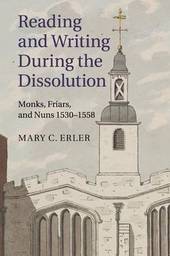
|
Reading and Writing during the Dissolution: Monks, Friars, and Nuns 1530-1558
Paperback / softback
Main Details
| Title |
Reading and Writing during the Dissolution: Monks, Friars, and Nuns 1530-1558
|
| Authors and Contributors |
By (author) Mary C. Erler
|
| Physical Properties |
| Format:Paperback / softback | | Pages:216 | | Dimensions(mm): Height 229,Width 152 |
|
| Category/Genre | Literary studies - c 1500 to c 1800
History of religion
Christianity
Church history |
|---|
| ISBN/Barcode |
9781316601938
|
| Classifications | Dewey:820.9002 |
|---|
| Audience | | Professional & Vocational | |
|---|
| Illustrations |
1 Maps; 5 Halftones, unspecified
|
|
Publishing Details |
| Publisher |
Cambridge University Press
|
| Imprint |
Cambridge University Press
|
| Publication Date |
21 January 2016 |
| Publication Country |
United Kingdom
|
Description
In the years from 1534, when Henry VIII became head of the English church until the end of Mary Tudor's reign in 1558, the forms of English religious life evolved quickly and in complex ways. At the heart of these changes stood the country's professed religious men and women, whose institutional homes were closed between 1535 and 1540. Records of their reading and writing offer a remarkable view of these turbulent times. The responses to religious change of friars, anchorites, monks and nuns from London and the surrounding regions are shown through chronicles, devotional texts, and letters. What becomes apparent is the variety of positions that English religious men and women took up at the Reformation and the accommodations that they reached, both spiritual and practical. Of particular interest are the extraordinary letters of Margaret Vernon, head of four nunneries and personal friend of Thomas Cromwell.
Author Biography
Mary C. Erler is a professor in the English department at Fordham University, New York and is the author of Women, Reading and Piety in Late Medieval England (Cambridge, 2002).
Reviews'Mary C. Erler's elegant examination of monastic reading and writing during the Dissolution revolves around six case studies representing different facets of religious life in early Tudor England. By drawing attention to their reading and especially their writing in the midst and aftermath of the Dissolution, Erler offers a more rounded picture of the regular clergy - as active participants in the English Reformation.' Martin Heale, The American Historical Review
|